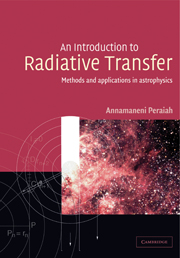Book contents
- Frontmatter
- Contents
- Preface
- Chapter 1 Definitions of fundamental quantities of the radiation field
- Chapter 2 The equation of radiative transfer
- Chapter 3 Methods of solution of the transfer equation
- Chapter 4 Two-point boundary problems
- Chapter 5 Principle of invariance
- Chapter 6 Discrete space theory
- Chapter 7 Transfer equation in moving media: the observer frame
- Chapter 8 Radiative transfer equation in the comoving frame
- Chapter 9 Escape probability methods
- Chapter 10 Operator perturbation methods
- Chapter 11 Polarization
- Chapter 12 Polarization in magnetic media
- Chapter 13 Multi-dimensional radiative transfer
- Symbol index
- Index
Chapter 7 - Transfer equation in moving media: the observer frame
Published online by Cambridge University Press: 05 June 2012
- Frontmatter
- Contents
- Preface
- Chapter 1 Definitions of fundamental quantities of the radiation field
- Chapter 2 The equation of radiative transfer
- Chapter 3 Methods of solution of the transfer equation
- Chapter 4 Two-point boundary problems
- Chapter 5 Principle of invariance
- Chapter 6 Discrete space theory
- Chapter 7 Transfer equation in moving media: the observer frame
- Chapter 8 Radiative transfer equation in the comoving frame
- Chapter 9 Escape probability methods
- Chapter 10 Operator perturbation methods
- Chapter 11 Polarization
- Chapter 12 Polarization in magnetic media
- Chapter 13 Multi-dimensional radiative transfer
- Symbol index
- Index
Summary
Introduction
Rapid expansion in nova, stellar atmospheres of supernovae and similar objects is established through several spectroscopic observations. In spectra of these objects, the absorption lines shift towards the violet side from the rest position indicating matter outflow in their atmospheres. These lines are accompanied by red shifted emission characteristics of P Cygni type as seen in figure 7.1 (see Beals (1950), Kuan and Kuhi (1975)). Beals (1929, 1931) interpreted the large widths in the lines of WR spectra to be due to the velocities of expansion of the order of 3000 km s-1 indicative of a rapid outflow of the matter in the outer layers of these stars. He suggested that this outflow of matter is influenced by the radiation pressure in the medium.
It is difficult to obtain the solution of the transfer equation in such spherical media. Beals (1929, 1930, 1931, 1934), Chandrasekhar (1934), Gerasimovič (1934) and Wilson (1934) investigated this problem assuming the medium to be optically thin, neglecting the transfer effects. Struve and Elvey (1934) found that the Doppler widths derived from the flat part of the growth curve were much larger than the thermal value, which they attributed to the ‘turbulent’ motion in the atmosphere which is non-thermal. Struve's observations (1946) showed large scale velocities through the fact that the line profile widths in certain stars were larger than the Doppler widths obtained from curve of growth analysis of their spectra.
Information
- Type
- Chapter
- Information
- An Introduction to Radiative TransferMethods and Applications in Astrophysics, pp. 193 - 216Publisher: Cambridge University PressPrint publication year: 2001
